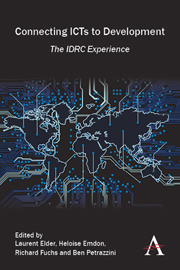Introduction Part I - From Heresy to Orthodoxy: ICT4D at IDRC
Published online by Cambridge University Press: 05 March 2014
Summary
Histories are written about people and events that are in the past. This book is not a history. Rather, it is a documentary or ethnography of a particular time in the business of foreign aid and of the ascendant role of Canada's International Development Research Centre (IDRC) in that time and space.
With the introduction of the first desktop computers in the mid-1980s, the postindustrial world was just awakening to the power and wonder of digital technologies. At the onset, the idea that digital technologies had something to do with social and economic development was a heretical notion. And it arose in unlikely locations in postindustrial North America and Europe – in places that were being bypassed by the first great wave of digital tools. In rural areas of Scandinavia, in the ghetto that was East Harlem, in the Australian outback and in rural outposts of Canada's poorest province, Newfoundland, the first attempts to “leapfrog” past an industrial revolution that had already left them as outsiders were beginning.
Ideas of how computers, email and networks might advance the interests of the marginalized and the poor in the developing world were also beginning to percolate. In Brazil, South Africa, the Philippines and other developing places, early pioneers and heretics were introducing the digital idea into more commonplace notions of how “development” might occur.
- Type
- Chapter
- Information
- Connecting ICTs to DevelopmentThe IDRC Experience, pp. 1 - 18Publisher: Anthem PressPrint publication year: 2013

